www.GemstoneBasics.com
Photomicrography > Quartz > with petroleum inclusions
First draft: March 4th, 2015 | Last update: March 23rd, 2016
Quartz with Petroleum, Methane, Bitumen, and Water (Petroleum quartz)
Zhob District, Balochistan Province, Pakistan
Being a particular kind of enhydro, doubly terminated quartz crystals containing negative crystals filled with petroleum, methane, bitumen, and water, are rare, though material of very good quality appears on gem and mineral fairs on a regular basis. Under ultra-violet radiation the petroleum inclusions present in the material reveal a strong fluorescent reaction.
This most striking material originates from the Zhob District in Balochistan Province, Pakistan, although some time ago one dealer had material on offer unearthed in the Jihouke District, Leshan Prefecture, Sichuan Province, China. However, these samples contained quite some bituminous matter, but far less petroleum and resemble herkimers with anthraxolite from the Adirondack Mountains in New York.
It might be interesting to note that petroleum inclusions similar to those in Pakistani quartz have also been found in quartz crystals originating from Bahia, Brazil (Gübelin & Koivula, 2005).
References and items of related interest
Gübelin, E.J. & Koivula, J.I. (2005). Photoatlas of Inclusions in Gemstones. Volume 2, p. 240, 551, 576, 578, 652. Opinio Publishers, Basel, Switzerland, 829 p., ISBN 3-03999-029-2.
Hyrsl, J. & Niedermayr, G. (2003). Geheimnisvolle Welt: Einschlüsse im Quarz | Magic World: Inclusions in Quartz. Bode Verlag GmbH, Haltern, Germany, 240 p. ISBN 3-92509481-4 (in German | English).
Michaels, J. (2012). Veins, Fluid Migration and Hydrocarbon Generation in the Utica Shale, Northern Appalachian Basin, New York. Colgate Academic Review, Vol. 9, Issue 1, Article 12, pp. 292-315.
O'Reilly, C. & Parnell, J. (1999). Fluid flow and thermal histories for Cambrian-Ordovician platform deposits, New York: Evidence from fluid inclusion studies. Geological Society of America Bulletin, Vol. 111, Issue 12, pp. 1884-1896. abstract
Photomicrographs

Negative crystal: methane & bitumen - Note the brown finely dispersed bitumous matter
25x (FoV ± 3.5mm) Obl

The arrangement of these negative crystals can sometimes be quite striking
6x (FoV ± 7.5mm) Obl
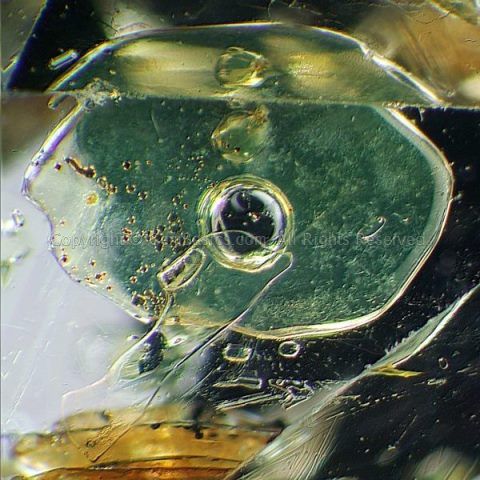
Negative crystal with moving bubble and bitumen
25x (FoV ± 2.5mm) Obl & TM, Sh, X-Pol
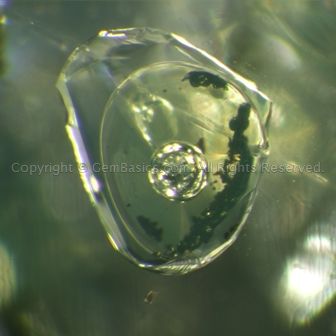
Negative crystal with clearly discernible features
40x (FoV ± 2mm) Obl & TM, Sh, Pol

Negative crystal: methane, petroleum & bitumen (spots)
30x (FoV ± 2.5mm) UVL, Pol
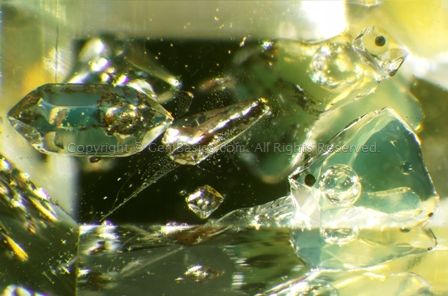
An overall view of the inclusion scene of a 1.97ct doubly terminated quartz crystal from Zhob
40x (FoV ± 2mm) Obl & TM, Sh, UVL, Pol
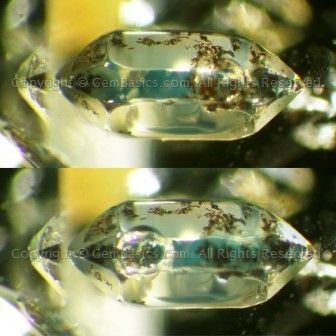
Negative crystal: moving methane bubble, petroleum & bitumen
18x (FoV ± 2mm) Obl, TM, Sh, UVL, Pol

Detail - Note the brown bitumous matter
40x (FoV ± 2mm) Obl & TM, Sh, UVL, Pol
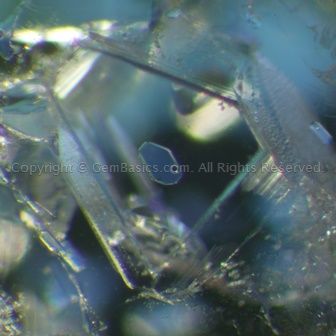
Quartz inclusion with negative crystal following crystallographic directions 40x (FoV ± 1.5mm) UVL, Pol
 35imgs LoRes.jpg)
The bitumen inclusions in this 1.35ct stone appear to be layered and bent: anthraxolite?
18x (FoV 3.45mm; DoF 1.02mm) Obl, Sh, X-Pol
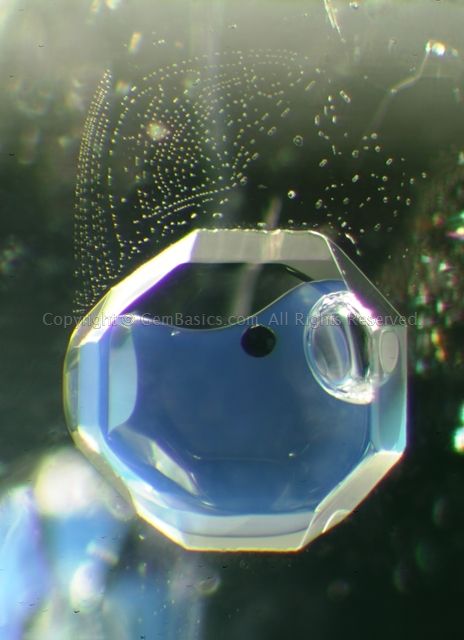
Petroleum, bitumen, gas bubble, and water - a textbook example
40x (FoV ± 1.5mm) UVL, Obl, TM, Sh
 LoRes.jpg)
The layers of this multi-phase inclusion lay parallel to one crystal face suggesting a similarity with phantoms
50x (FoV ± 2mm) TM, Sh, X-Pol (15 images)
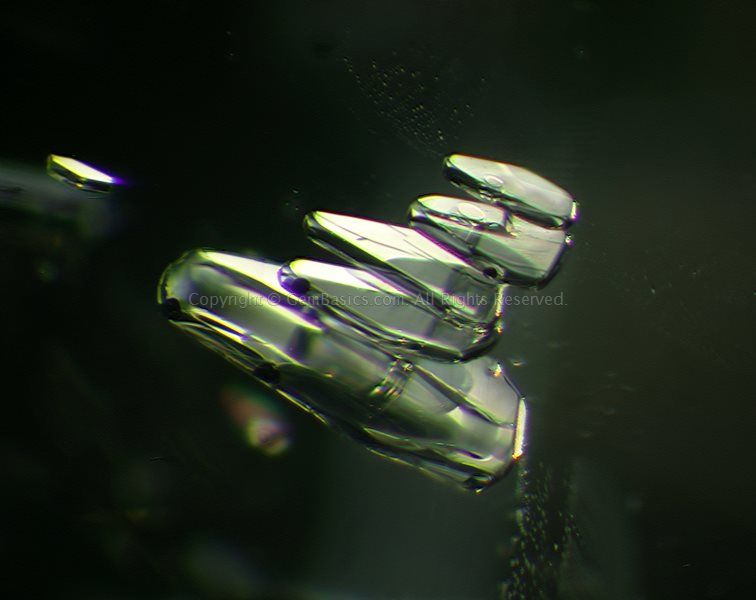
Observed from another angle - note the connecting channels
50x (FoV ± 2mm) DF, Obl, Pol
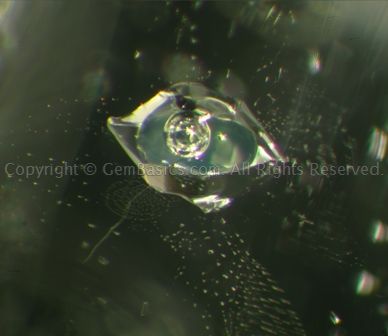
Some tiny negative inclusions with typical filling
50x (FoV ± 1mm) DF, Obl, Pol
 LoRes.jpg)
With the aid of a digital caliper, intermediate focusing steps can be better monitored resulting in sharper images
25x (FoV ± 2.5mm) Obl, Sh, Pol
 66imgs LoRes.jpg)
This practice improves sharpness especially of complex inclusions
18x (FoV 3.51mm; DoF 1.914mm) Obl, Sh, Pol
During a meeting with the supplier of the material featured in the above photomicrographs on a mineral and gem fair in March 2016, a substantial parcel of smaller rough bi-terminated stones ranging from about 0.80 to 2 carats was presented. I was specifically looking for phantoms filled with the typical phases.
One of the selected bi-terminated specimens is this 2.12-carat stone with plenty of moving bubbles and a petroleum inclusion which is surrounded by a "halo" of phantom-like layers with trapped brownish bituminous matter. The layers are clearly defined by their outline and orientation, following the crystal faces.
.jpg)
A "halo" of layered bitumen-filled negative inclusions
9x (FoV 12.28mm) Obl, X-Pol
 LoRes.jpg)
This view clearly shows the inclusion's layered buildup and some connecting channels

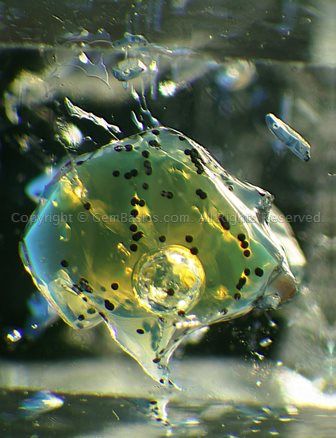
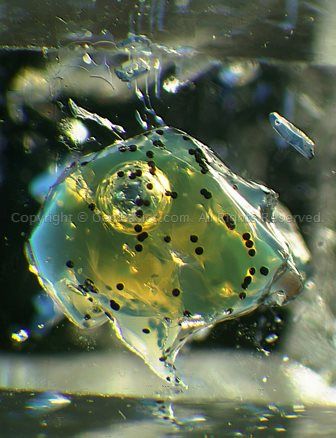
 17imgs LoRes.jpg)
 LoRes.jpg)
 9955 LoRes.jpg)